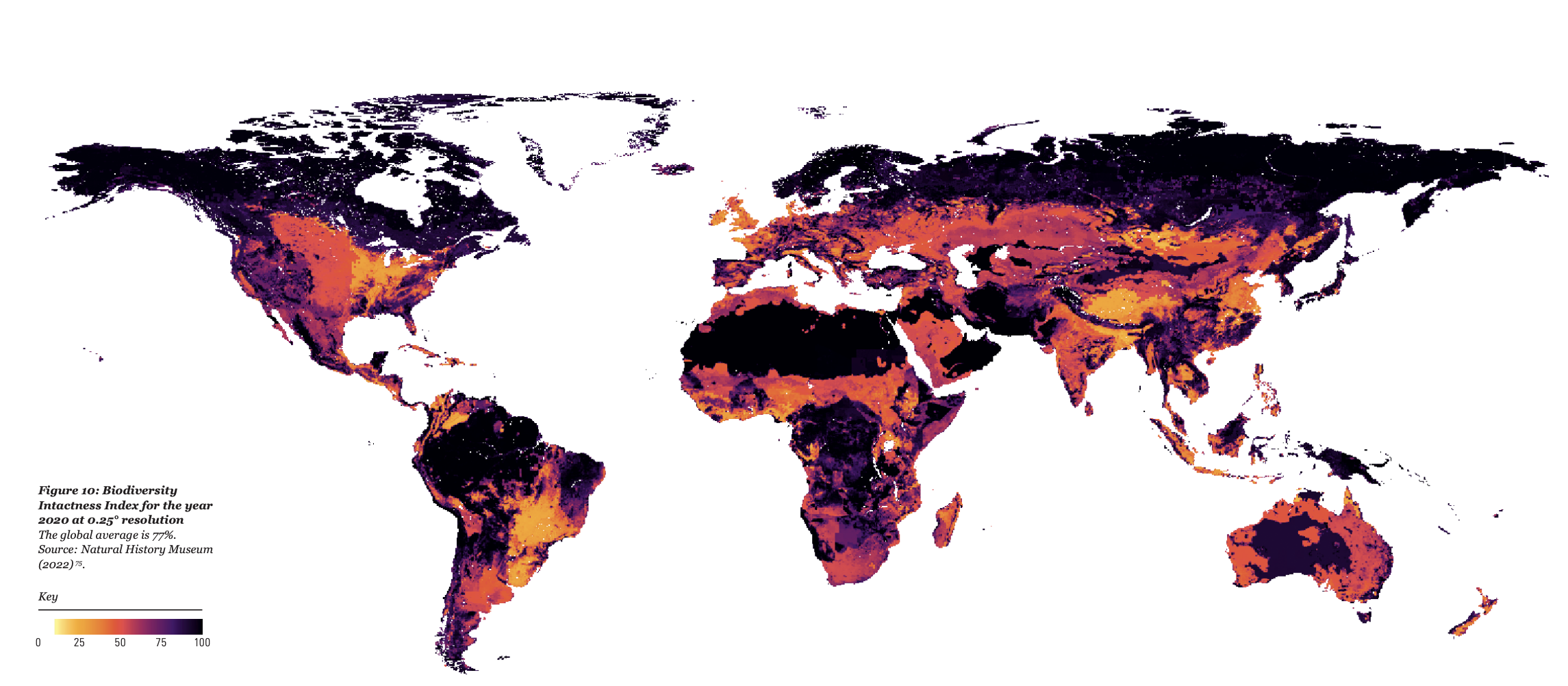
The topic is on everyone’s minds: biodiversity is collapsing and the essential basic services provided by living ecosystems are at risk. The word “biodiversity” is often used to address functional or ecosystem diversity, and more generally to represent the variety of life forms on Earth, their habitats and communities, deeply linking this concept to nature.
After failing to achieve most of the targets of the 2011-2020 Strategic Plan for Biodiversity, we now have the multilateral Kunming-Montreal Global Biodiversity Framework (GBF), which highlights the pressing need to preserve and restore biodiversity and establishes global goals and targets to achieve that. We are also entering a time of stringent requirements for biodiversity impact reporting, particularly with the CSRD. Governments are also moving with regulations to prevent further biodiversity loss, like the Regulation on Deforestation-free products in the EU, the Biodiversity Net Gain in England, among others.
With a voluntary biodiversity market developing, a rise in nature tech players, and an increased need for holistic sustainability strategies, we are moving towards an era of strategic sustainability actions, backed by top-notch tech solutions that tackle biodiversity loss and empower companies to be nature positive. In this “Insight” article, we want to introduce the different solutions available for biodiversity management, ahead of our Biodiversity Management Deep Dive (part of our Digital4Impact Tech Radar).
Biodiversity has been steeply declining
There are 4 types of metrics that reflect biodiversity impact:
- ecosystem condition metrics
- species extinction risk metrics
- monetary metrics
- elementary indicators (e.g. tree cover, species occurrence, etc.)
Ecosystem condition and species extinction risk are used by all the major frameworks (CSRD, GRI, TFND, SBTN) and are basically established as the main metrics to focus on.
At a global level, biodiversity loss is assessed through global extinction rates, which have been increasing. Around 25% of species assessed by the IPBES in the animal and plant groups are threatened, suggesting that up to one million species are threatened with extinction that could happen within decades.
There has been a loss of 86% of wild mammal biomass on Earth, and humans and livestock currently account for nearly 96% of all mammal biomass. This decline is intimately connected to the modification of 77% of land areas (excluding Antarctica) and 87% of ocean, driven by human activities. Ecosystems like parts of the Amazon rainforest and wetlands, which absorb large amounts of carbon, are shifting from carbon sinks to carbon sources due deforestation and other land-use change. These are clear cases where the both biodiversity crisis and climate change are negatively impacted through anthropogenic actions, and should urge us to act against both.
The Biodiversity Intactness Index (BII) uses statistical models of how local biodiversity responds to land use and related pressures, resulting in a percentage that indicates the average abundance of a large, taxonomically and ecologically diverse set of naturally-occurring species when compared to a baseline of minimal human impact. The BII ranges from 100 to 0%, with 100% representing an undisturbed natural environment with little to no human impacts. A BII of 30% or less indicates that the biodiversity in a specific area has been depleted and the ecosystem could be at risk of collapse.

Source: WWF
When observing the world through a lens of the BII, we can see that many of Earth’s areas have already reached a BII of 50% or less, making apparent the urgency of actions to reverse this and protect biodiversity.
For the success and growth of initiatives aiming to protect biodiversity at a local-level, there is a strong need to engage with Indigenous Peoples and Local Communities (IPLC). The GBF has provided more space for IPLC’s participation when compared to other multilateral environmental agreements, a major step in both social and environmental areas, because:
- 80% of the world’s biodiversity is in areas traditionally owned, managed, used and or/occupied by IPLCs (even though they are only about 5% of the world’s population);
- IPLC hold knowledge essential to setting realistic and effective biodiversity targets;
- IPLC’s conceptualizations and understandings of nature are in line with CBD’s 2050 vision of “a world living in harmony with nature”;
- IPLC’s participation in biodiversity policy as rights-holders strengthens the social elements that are essential to meet CBD’s 2050 vision.
Climate Change, Biodiversity and the other Planetary Boundaries: Feedback Loops and Interactions
The five main drivers of biodiversity loss are land use change, invasive alien species, direct exploitation of organisms, pollution, and climate change.
Geosphere-biosphere interactions are an internal driver of Earth’s state, therefore biosphere integrity, one of the planetary boundaries, is considered a “core boundary” in the Planetary Boundaries framework, alongside Climate Change (which can be used as a proxy for the geosphere). Research is increasingly showing that transgressing either one of these boundaries can lead to negative effects on the other.
Climate Change has become more and more relevant when talking about biodiversity loss. It has affected the state of marine, terrestrial, and freshwater ecosystems around the world, consequently causing the loss of species, the increase of diseases and even the mass loss of plants and animals. The increase in temperatures around the world can significantly affect biodiversity and negatively affect climate change adaptation/mitigation measures due to the steep decrease of ecosystems that are invaluable natural carbon sinks.

Source: WWF
The biosphere integrity boundary, representing biodiversity, interacts with all other boundaries. Reaching the boundaries of ocean acidification, land use, climate change, nutrients, and water can have large impacts on biodiversity especially because some of these are part of the 5 main drivers of biodiversity loss.
In contrast, biome-level biodiversity changes can also have significant feedback on climate change by impacting the fluxes of GHG, water cycles and nutrient cycles. More than 50% of the absorption of anthropogenic GHG is due to photosynthesis and consequent storage of carbon in biomass and organic matter. In general, as biosphere integrity gets closer to its’ boundary, it negatively influences the condition of other boundaries, which can then feedback on biodiversity. Clearly, biodiversity has a major role in attenuating climate change, through the development and implementation of ecosystem-based approaches to adaptation, which fall under de concept of nature-based solutions (NbS). This is supported by the claim made by environmental organizations and academic researchers that NbS could contribute 16 to 37% of GHG mitigation.
NbS often interact directly with biodiversity, and although their development often has carbon tunnel vision, we are witnessing the increase of attention on NbS projects’ co-benefits, such as biodiversity restoration, that can lead to a price premium on carbon credits. Carbon credit buyers are also giving more and more importance to high-quality credits originating from NbS, leading project developers to engage in the shaping of the biodiversity voluntary market. By leveraging the lessons from the quite mature Voluntary Carbon Market, the VBM can be a success in stimulating biodiversity restoration.
The interactions and feedback of different systems and processes with biodiversity are still not fully understood, and further research on the impacts of climate change on biodiversity is needed. At the same time, there is an important need to manage synergies and trade-offs between climate change adaptation/mitigation measures and biodiversity. This need is being incorporated into recent disclosure frameworks on Biodiversity impacts, such as the GRI 101 and the CSRD, with growing recognition that limiting global warming and protecting biodiversity are mutually supporting goals.
Leveraging digital technologies for biodiversity management
There is a growing push from regulatory bodies to report on nature’s impacts, motivating investment in tech solutions that can provide insights into nature and biodiversity footprints, risks and impacts. Unlike carbon, there is no unified metric for the measurement of biodiversity impacts, but tools and methodologies are evolving to provide more accurate data on the extent of impacts, such as the Integrated Biodiversity Assessment Tool (IBAT) and the Living Planet Index (LPI).
Nature tech is defined as a broad set of technologies that can address a range of environmental challenges, including habitat destruction, deforestation, species loss, and much more. Nature tech can aid in biodiversity data collection and monitoring and in bridging the gaps between stakeholders.
Among the nature tech solutions that address the biodiversity crisis there are multiple categories, that will be briefly described below.
Biodiversity MRV includes solutions like Wildlife Acoustics which provides their customers with recorders for birds and bats, and a bioacoustics sound analysis software to quickly identify species and report findings. Within the MRV category, there are also companies such as Biometrio that provide bioacoustic solutions and additionally, imaging solutions to identify species.
An up-and-coming category of MRV for biodiversity is environmental DNA (eDNA) analysis, a reproducible and standardised method that allows precise detection of species and measurement of biodiversity through the analysis of environmental samples (soil, water, air, or biological samples). eDNA analysis providers oftentimes provide sophisticated platforms where the client can access digested insights that facilitate decision-making. Within this category, there are leading companies like SpyGen and NatureMetrics, which will be included in our Digital4Impact Tech Radar.
In line with the increasingly demanding reporting requirements, regulatory bodies such as the TFND and the SBTN set the best practices and provide tools that support their methodologies of impact assessment and target setting. TFND has the “TFND in a box” tool which supports the LEAP Approach, and SBTN has multiple tools to assess materiality and support their 5-step methodology (Assess, Prioritize, Measure, Act, Track).
There are solution providers that, in our understanding, do not fit into the nature tech category, but are nevertheless important in fighting against the biodiversity crisis. Among these are project developers who have a strong focus on biodiversity (often alongside carbon) and are shaping the voluntary biodiversity market, such as Nattergal and Value Nature.
Many more players are entering the nature tech market, embarking on a journey to tackle the biodiversity crisis. Among them, we have flagged Dunya Analytics, Biodiversity, and others. Stay tuned to our Biodiversity Tech Radar Deep Dive, coming in the following weeks, to find out about these and more companies that can help solidify your biodiversity strategy.
References
Biodiversity Indicators Partnership
IPBES-IPCC Co-sponsored Workshop Report on Biodiversity and Climate Change
Katherine Richardson et al: Earth beyond six of nine planetary boundaries
Kunming-Montreal Global Biodiversity Framework
Nature-based solutions can help cool the planet — if we act now
NbS for climate change mitigation, UNEP, IUCN 2021
The Guardian: Biodiversity Crisis in Numbers
The Guardian: More than half of Earth’s species live in the soil, study finds
UN: Biodiversity – our strongest natural defence against climate change
WWF: Living Planet Report 2022
WWF: Recognizing Indigenous People’s Land Interests is Critical for People and Nature

Laima Barros
Jr Sustainability Consultant
Check out our Digital4Impact Tech Radar, to get more insights into companies offering Remote Sensing-based solutions for the environment, Carbon Management platforms, or Sustainability Management Technologies.
Impact Labs CSRD Offer
We are happy to introduce our tailored CSRD service offer, designed to simplify compliance with the new regulations and drive impactful sustainability strategies. This way, teams can focus on reducing their footprint and developing effective nature strategies.
We streamline the CSRD reporting process with relevant tech and tools to make it as smooth and efficient as possible. Our service is designed to guide you through every step of this transformative journey.
Checklist on 10 key aspects to consider when selecting a CSRD Tool
Selecting the right technology for implementing the Corporate Sustainability Reporting Directive (CSRD) involves several key considerations to ensure compliance, efficiency, and effectiveness.
#REBOOT Business 12 – Une Economie Plus Juste
EPISODE SUMMARYAu fil des podcasts Reboot se dessine une ligne convergente vers l’urgence impérieuse de changer le système dans sa globalité. C’est...





